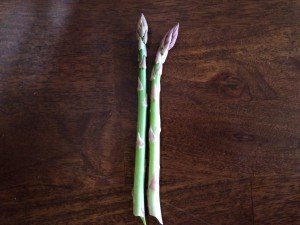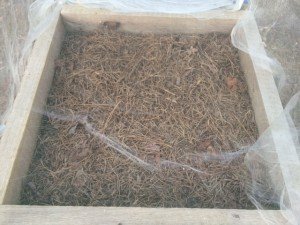This year, in particular, is full of new beginnings. I welcomed the New Year in with a toast and a cheer from my home in Apex, NC. Just a few months later, this native midwesterner calls Long Island, NY home.
The question I was asked most often about the move was, "Are you going to take your garden with you to New York?". I had 11 individual 4'x4' beds for annuals that constituted the main garden. Separately I had 3 individual 4'x4' beds that were permaculture consisting of asparagus in one, strawberries in another and herb garden in the third. The family that is buying my house in a few weeks will inherit these three boxes. The other 11 beds are disassembled and stored in the basement of the house I am renting for a bit.
The second most common question was, "Will you be able to grow anything in the cold up there?". This question was a curious one to me. I had check the Hardiness Zone Map and both Apex and most of Long Island are Zone 7b, but no one could believe that Long Island and Raleigh are roughly the same growing climate. Despite the incredulity of the south, I should be able to grow roughly the same varieties and seasons in NY as I did in NC.
For the first year while I rent, my growing will be restricted to hydroponics and containers. I am looking forward to a year from now, buying some asparagus crowns and a backyard to put them in!
Read MoreThis post comes after more than a year of researching every way I can think of and completely failing to find anything related to the matter at hand. The matter at hand is the second growth of asparagus spears in the early fall, long after the asparagus crowns have been allowed to grow the long, bushy fronds they need in order to feed the crown for next year's growth and more specifically, whether or not a small portion of the second growth can be harvested.Unable to find any information either for or against sneaking a few of these late season spears, I have had to reason this out for myself for the past two years and while the result is probably entirely predictable (Garden fresh asparagus in fall? Yes please!), I like to think my reasoning well rooted in a layman's pseudo-botany. The rationale goes something like this: the individual asparagus crowns have been photosynthesizing since May, and of the new spears coming up in September/October I am only taking about 1 out of every 3 of the new growth spears and then only off of crowns that already have more than 3 stems that have fully grown out and are working hard to supply nourishment to the crown to take it through winter and make a stronger growth next year.With 16 crowns all together (8 Jersey Knight and 8 Purple Passion) all of which are enjoying a youthful resurgence right now, this equals out to around 4-5 spears per week that are coming indoors and leading to some interesting, not-normally-on-the-same-plate combinations. This afternoon for lunch, I sauteed some asparagus picked 30 minutes earlier along with some Italian kale harvested at the same time.But my favorite has been adding asparagus to my Whatever Is Fresh Scrambles!This one featured rehydrated morels, 4 spears of asparagus, 4 cherry tomatoes and 2 red serrano peppers - all from the garden except for the morels. I saute all ingredients except the more delicate tomatoes in butter with a little olive oil until the asparagus is just shy of done.When the asparagus has softened, add scrambled eggs to the mix then fold in the quartered cherry tomatoes.When the eggs have finished cooking, plate with a little shredded cheese of your choosing - I have used both colby-jack and mozzarella and both have worked wonderfully. Top with your choice of fresh herb (I alternate between basil and dill) and voila - delicious and nutritious meal in just a few minutes!
Read MoreEgg scrambles for dinner with almost any leftover veggies in the fridge is a quick and easy decision for nights that lack a dinner plan.I had a small bunch of kale leftover after an Italian soup earlier in the week so I chopped it up and sauteed with some rehydrated morels. Add in scrambled eggs and herbs/seasoning of choice (I used fresh tarragon and a little cayenne), top with a little cheese and viola - a delicious, nutritious and frugal dinner!As a side note on a side dish - a couple of weekends ago I processed 15lbs of my Roma Tomatoes into sauce. 2lbs of sauce to be exact. I divvied up the sauce into freezer bags and started looking for other uses for the Romas I am growing. I have diced them up into tomato salads along side the slicing and cherry tomatoes and lately I have been working on pan roasted tomatoes (above). They taste delicious but the skins are a bit like tough paper after the roasting...still a work in progress.
Read MoreIn mid-April I had to concede defeat in my attempt to grow morel mushrooms and turned my attention to procuring dried morels instead. After a lot of price shopping I decided to try LifeGourmetShop.com and while I waited for my package to arrive, I started researching how to use dehydrated morels in place of fresh ones.The available information on rehydrating morels is generally straightforward with a few notable exceptions. Mushrooms should be placed in a liquid for around 20 minutes. What type of liquid is at the discretion of the chef, but most agree that water is just fine. Some people recommend hot water while other say that hot water will pull more of the morel flavor from the mushroom to the water.Taking the more conservative approach, I have used cold water with great effect and based on the heavy morel perfume and coloring of the cold water after a 20 minute soak, I think cold is the best approach. For the past month I have been enjoying morels that look, feel and taste *almost* like fresh morels in everything from omelets and pasta sauce to mixing them in with ground beef for hamburgers and stir fries. But what to do about all that mushroomy goodness left in the water they were soaked in?Luckily, one of the sites I searched had a great tip - filter the morel water and use it as a partial or whole replacement for water or stock in recipes that would be complimented with a bit of umami.A paper towel tucked over the opening of a container makes a great strainer to remove any grit or debris that may have been tucked into the folds of the morel for fresh uses (next 2 days). Strain and pour into ice cube trays, then pop out the cubes and place in a freezer safe bag for a longer shelf life.Since learning this trick I have been using the golden liquor to replace potions of chicken, beef and vegetable stock as well as added to water for boiling pasta. It's a great way to stretch my borrowed harvest for this year into many more dishes and over a longer period.My 6th grade Home Ec teacher would be proud!
Read More



